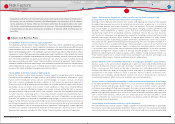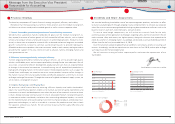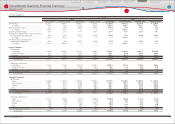Toyota 2010 Annual Report Download - page 27
Download and view the complete annual report
Please find page 27 of the 2010 Toyota annual report below. You can navigate through the pages in the report by either clicking on the pages listed below, or by using the keyword search tool below to find specific information within the annual report.
TOYOTA ANNUAL REPORT 2010 25
Corporate Social Responsibility
Toyota’s Basic Approach to Internal Control System
To maintain stable, long-term growth in international society, companies have to earn the respect and trust
of society and individuals. Rather than simply contributing to economic development through operational
activities, growing in harmony with society is a must for good corporate citizens. Mindful of the foregoing,
Toyota has a range of committees that are tasked with monitoring corporate activities and management in
relation to social responsibilities, including the CSR Committee and the Toyota Environment Committee.
integrate the principles of problems identication (“Mondai Hakken”) and continuous improvements
(“Kaizen”) into our business operation processes and make continuous eorts to train our employees
who put these principles into practice.
With the above understanding, internal control has been developed under the following basic policies.
(1)System to ensure that the Directors execute their responsibilities in compliance with
relevant laws and regulations and the Articles of Incorporation
1)Toyota will ensure that Directors act in compliance with relevant laws and regulations and the
Articles of Incorporation, based on the Code of Ethics and other explanatory documents that
include necessary legal information, presented on occasions such as trainings for new Directors.
2)Toyota will make decisions regarding business operations after comprehensive discussions
at the Board meetings and other meetings of various cross-sectional decision-making bodies.
Matters to be decided are properly submitted and discussed at the meetings of those decision-
making bodies in accordance with the relevant rules.
3)Toyota will appropriately discuss significant matters and measures relating to issues such as
corporate ethics, compliance, and risk management at the CSR Committee and other meetings.
Toyota will also discuss and decide at the meetings of various cross-sectional decision-making
bodies policies and systems to monitor and respond to risks relating to organizational function.
(2)System to retain and manage information relating to performance of duties by Directors
Information relating to exercising duties by Directors shall be appropriately retained and managed by
each division in charge pursuant to the relevant internal rules and laws and regulations.
(3)Rules and systems related to the management of risk of loss
1)Toyota will properly manage the capital fund through its budgeting system and other forms of
control, conduct business operations, and manage the budget, based on the authorities and
responsibilities in accordance with the “Ringi” system (eective consensus-building and approval
system). Signicant matters will be properly submitted and discussed at the Board meetings and
other meetings of various bodies in accordance with the standards stipulated in the relevant rules.
2)Toyota will ensure accurate financial reporting by issuing documentation on the financial
flow and the control system etc., and by properly and promptly disclosing information
through the Disclosure Committee.
3)Toyota will manage various risks relating to safety, quality, the environment and compliance by
establishing rules or preparing and delivering manuals, as necessary, in each relevant division.
4)As a precaution against events such as natural disasters, Toyota will prepare manuals,
conduct emergency drills, arrange risk diversification and insurance as needed.
(4)System to ensure that Directors exercise their duties efficiently
1)Toyota will manage consistent policies by specifying the policies at each level of
the organization based on the medium- to long-term management policies and the
Company’s policies for each fiscal term.
2)The Chief Ocer, as a liaising ocer between the management and operational functions, will
direct and supervise Managing Officers based on the management policies and delegate the
Based on the “Guiding Principles at Toyota” and the “Toyota Code of Conduct,” we, together with our
subsidiaries, have created and maintained a sound corporate climate. In our actual operations, we
Emphasizing Frontline Operation + Mulitidirectional Monitoring
Shareholders
Disclosure Committee Internal
Auditing Department
(internal control systems)
Board of
Directors
Managing
Officers
Labor-Management Council
Joint Labor-Management
Round Table Conference
CSR Committee*
Toyota Environment Committee
Stock Option Committee
* Review issues relating to corporate ethics, legal compliance, risk management, nurturing society and environmental management
Appointment
■ Toyotas Corporate Governance
External
Accounting Auditor
Audit for consolidated financial
statements and internal control
over financial reporting
Board of
Corporate Auditors
Majority are outside
corporate auditors
Senior Managing
Directors
International Advisory Board
For internal audit, the management and a specialized independent organization evaluate the
effectiveness of internal controls over financial reporting in accordance with Article 404 of the
U.S. Sarbanes–Oxley Act, applicable to Toyota from the year ended March 31, 2007 to establish a solid
system. In addition, in accordance with Article 24-4-4-1 of the Financial Instruments and Exchange
Law, which is applicable to Toyota starting with the year ended March 31, 2009, there is an assessment
system to ensure that nancial statements and other nancial information are prepared properly. In
order to enhance the reliability of the nancial reporting of Toyota, the three auditing functions, audit
by Corporate Auditors, internal audit, and accounting audit by Independent External Auditors, aid in
conducting an effective and efficient audit through meetings held periodically and as necessary to
share information and come to understandings through discussion on audit plans and results.
Corporate Philosophy
Special Feature
Top Messages
Corporate Philosophy
Risk Factors Other Management and Corporate Data
Special Feature
Consolidated
Performance Highlights
Financial Section
Investor Information
Corporate Information
Business Overview
Management Team Corporate Governance
Corporate Governance
Corporate Information
R&D and Intellectual Property
























